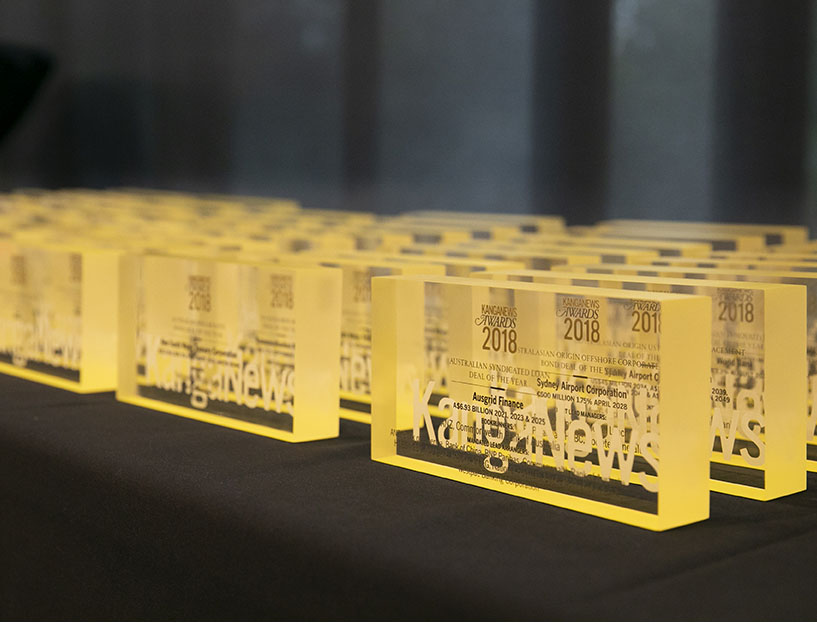
Australian corporates push the boundaries of sustainable funding
An extended issuance hiatus could slow progress, but Australian corporate borrowers continue to show willingness to engage with new sustainability-linked products. Sydney Airport and Wesfarmers have completed new sustainability-linked funding – the former as the first such issuer in any global bond market.
Matt Zaunmayr Deputy Editor KANGANEWS
Sydney Airport’s market leadership, and the willingness of US private placement (USPP) investors to provide structural flexibility, were crucial to the execution of the world’s first sustainability-linked bond (SLB) with two-way pricing. Deal sources are bullish on proliferation of the product over time.
The A$100 million (US$61.7 million) sustainability-linked tranche was part of a A$600 million equivalent deal, priced on 12 February, in Australian dollars, euros and US dollars, with maturities from 15-30 years (see table). MUFG Securities (MUFG), National Australia Bank (NAB) and Scotiabank led the transaction.
Sydney Airport’s group treasurer, Michael Momdjian, says the entire transaction was well received, pricing inside the tight end of guidance and with a four times oversubscription. The deal’s foreign currency exposures are 100 per cent hedged over the life of the bond. The maturities incorporate four months of free delayed settlement.
Pricing on all tranches compared favourably with recent prior USPP and Australian dollar public-market transactions, leads and issuer add.
There were 14 investors. While several institutions indicated strong interest in the SLB tranche, MetLife Investment Management and Northwestern Mutual took down all the SLBs.
Sydney Airport USPP deal structure
| Tenor (years) | Volume | Sustainability linked |
|---|---|---|
| 15 | €50m | N |
| 15 | US$52m | N |
| 20 | AS$220m | N |
| 20 | A$100m | Y |
| 30 | A$120m | N |
Source: Sydney Airport 17 February 2020
Steps up and down
The SLB tranche marks progress in debt capital markets’ attempts to address environmental, social and governance (ESG) considerations. Sydney Airport and its leads say the USPP deal is the first in any market to include both a pricing step up and step down based on whether the issuer meets ESG-related targets.
Internationally, 2019 saw two SLBs issued by Italian energy company, Enel. However, these included only a potential step up in pricing – a penalty to the company if it misses ESG targets. The inclusion of a step down when issuers do meet targets has been more difficult for investors to accept.
Other developments in ESG-linked debt instruments during 2019 included Sydney Airport’s landmark sustainability-linked loan (SLL). This was the largest-ever SLL in the Asia-Pacific region and the first in Australia to include step-down provision.
Some market participants believe two-way pricing is crucial for the development of SLBs. “The premise of our SLL and SLB was to drive behavioural change that would incentivise better sustainability performance and discourage worse sustainability performance – not just one or the other,” Momdjian tells KangaNews.
The USPP market has long been willing to accommodate novel deal structures. Sydney Airport’s lead managers say this made it a suitable place for a world-first transaction of this nature, even if US investors have not always been leaders in ESG instruments.
Geoff Schmidt, general manager, corporate finance North America at NAB in New York, argues that attitudes towards ESG have changed among USPP investors over the last 12-24 months.
“The USPP market is the perfect environment to test these structures,” Schmidt says. “The investors are buy-and-hold, and have a sophisticated understanding of credit and deal structures. The wide adoption of foreign currency tranches and delayed settlement have proven this. Wider adoption of sustainabilitylinked structures can also take place going forward.”
MUFG’s New York-based director, private placements, Peter Brooks, adds: “USPP investors are able to provide bank-like terms for a bond-format transaction, which means USPP can lead public markets on instruments such as SLBs. We hope this successful inaugural deal opens the door for discussions with more issuers.”
The structure garnered buy-side interest beyond the investors that participated. Momdjian says more than 10 accounts expressed an interest in understanding and analysing the SLB proposition.
“Some investors were not yet ready to participate, while others were keen but were priced out of the transaction,” Momdjian explains. “One investor participated in the SLB and not the vanilla tranches, suggesting the SLB component actually increased demand.”
Deal structuring
Sydney Airport’s SLL from 2019 began as a refinancing of its vanilla loan facility before any sustainability-linked targets or step-up and step-down provisions were included. This ensured the SLL would be priced at least at the same level as a vanilla loan, rather than attracting any premium for its more novel functions.
The SLB deal process featured a similar approach. Sydney Airport included a 20-year vanilla tranche that priced at the same level as the 20-year SLB. Not only does this ensure the bond is priced in line with conventional debt, it also makes explicit any premium or discount incurred from missing or meeting ESG targets.
The SLB and SLL are both based on an ESG risk rating determined by Sustainalytics. Momdjian says this allows Sydney Airport to drive improvement across the ESG spectrum, rather than just through internally derived targets.
The issuer believes the active leadership it has demonstrated in the ESG arena made it the ideal first mover for the structure in the USPP market, while its SLL provided a platform from which it could align the structure and targets of an SLB debut. Momdjian says the participation of more than 10 banks in the SLL likely made USPP investors more comfortable with the latest deal.
The transaction is also the issuer’s third visit to the USPP market so investors are familiar with the credit and acknowledge its strong fundamentals, the leads say. Schmidt says Sydney Airport’s strong credit was especially important because it was the first issuer to offer this structure.
The deal was in the pipeline for a while, as investors requested more education to help them get to grips with – and appropriately price – the SLB component. “This included the ability of investors to receive hedge-accounting treatment on their Australian dollar swaps and the ability of their back and middle offices to facilitate two-way coupon movements,” Brooks comments.
He adds that the participating investors are market leaders in providing structural flexibility for complex transactions and in their focus on sustainability. They can also invest in Australian dollars, making them ideal candidates.
Potential proliferation
SLBs have many moving parts. Issuer targets, verifier and certifier requirements, and investor demands all need to be considered. However, Schmidt says the USPP market should understand the structure now the first deal has been completed. Deals could proliferate as a result.
“Once the structure is understood, it is just a matter of bringing buyers and sellers together,” Schmidt comments. “This tranche was driven by two investors but many more are interested in ESG-linked deals.”
From the issuer side, the great promise of SLLs and SLBs is that they can potentially be applied to a bigger proportion of a company’s debt than use-of-proceeds products such as green bonds and green loans. If investors and issuers widely accept SLLs and SLBs, the ESG-linked debt universe could expand rapidly.
Momdjian says banks and Australian investors have already asked Sydney Airport about how the deal was structured and executed. Further sustainability-linked financing for the issuer will depend on whether such deals can help meet its core objectives. “We are focused on negotiating tight pricing before overlaying any sustainability-linked elements,” Momdjian asserts.
Wesfarmers hits loan market
Meanwhile, SLLs continue to gain traction in Australia. Wesfarmers is the latest borrower to establish a facility linked to environmental and social goals, which it says are ambitious and will improve its overall credit profile. Wesfarmers closed a bilateral A$400 million SLL with Commonwealth Bank of Australia (CommBank) on 13 March. The loan features margin steps-up and down based on two target metrics, one of which is environmental and the other social.
Naomi Flutter, executive general manager, corporate affairs at Wesfarmers in Perth, says the issuer chose the SLL specifically because it fits with the company’s general debt portfolio and does not carry the extra administrative costs of a use-of-proceeds financing instrument.
Bank sources have expressed significant confidence about SLL growth precisely because the product is a more natural fit for Australian corporates – which typically have loan-predominant debt books and limited supply of green-qualifying assets.
The ability to incorporate social targets into the loan was also important. Flutter explains: “There are plenty of opportunities to borrow money linked to environmental targets. This is a good development. But sustainability is linked to Wesfarmers’ core purpose of bringing satisfactory returns to shareholders and this is fulfilled only when the needs of all stakeholders are met. This includes workers, our supply chain and the communities in which we operate.”
SLLs must set ambitious targets to achieve the desired impact of transforming finance and materially benefiting the wider community by meeting climate-change and social challenges. Wesfarmers’ SLL uses internal metrics for its targets. All the company’s sustainability goals, including those linked to the loan, are reported on and EY audits them yearly.
Mark Peacock, head of sustainable finance at CommBank in Sydney, tells KangaNews discussions with Wesfarmers emanated from the company’s existing commitments to sustainability, which include targets across its business and an integrated sustainability report. The SLL’s criteria align with Wesfarmers’ broader sustainability targets but were developed specifically for the transaction.
The environmental goal is to reduce the emissions intensity of ammonium nitrate production over the tenor of the loan. Ammonium nitrate is an explosive used in bulk resources sectors, including iron-ore mining. The aim is to help Wesfarmers meet the sustainability target it has put in place for its chemical businesses, which is to beat the mean emissions intensity of peers by 2025.
Peacock says this is the most difficult part of the Wesfarmers business in which to abate emissions, and this is specifically why CommBank wants to incentivise improvement in this area. “There are many industries and sectors where emissions abatement is difficult but these are the areas where there is the most benefit from applying these loans,” he comments.
Wesfarmers’ social target is to increase representation of Aboriginal and Torres Strait Islander people in its workforce to 3 per cent. The demerger of Coles from the group caused the proportion of indigenous employees to fall to about 1.6 per cent, Flutter says.
Wesfarmers wants to rectify this. “We learned a lot through the process of increasing Aboriginal and Torres Strait Islander employment in Coles and we are now seeking to apply this to our other businesses so we can once again be in line with the benchmark,” Flutter comments.
Wesfarmers will gauge its progress against the loan targets by whether it achieves milestones it has in place for every six months relative to a baseline level set at 31 December 2019.
The way forward
The SLL has been vaunted for its potential to greatly expand the set of companies that can be incentivised to improve ESG performance through funding.
Peacock says inbound enquiry on the product is now huge, but he stops short of saying there will be an immediate explosion in its use. “Demand for the product is rising and it is certainly encouraging to see a greater diversity of borrowers using these loans to improve performance. Many more corporates have interest but there is still work for a lot of them to do on reporting infrastructure and setting targets.”
The SLL product also has the potential to expand the universe of other sustainability-funding products, such as green bonds. These need to be linked to specific assets that already have proven environmental performance. Some borrowers suggest employing such use-of-proceeds products is a desired end state for companies, while SLLs are for companies transitioning to that state.
Wesfarmers would be more likely to increase its funding through general-purposes debt products like SLLs than take on the extra administrative costs of use-of-proceeds funding, Flutter says. “We see more benefit in directing those funds towards further emissions-abatement initiatives or social targets,” she explains.
The overall benefit of undertaking sustainability funding is clear. “What we are doing makes our business more sustainable and our credit more robust,” Flutter says. “This should be reflected in the margin we pay on borrowing.”

WOMEN IN CAPITAL MARKETS Yearbook 2023
KangaNews's annual yearbook amplifying female voices in the Australian capital market.












